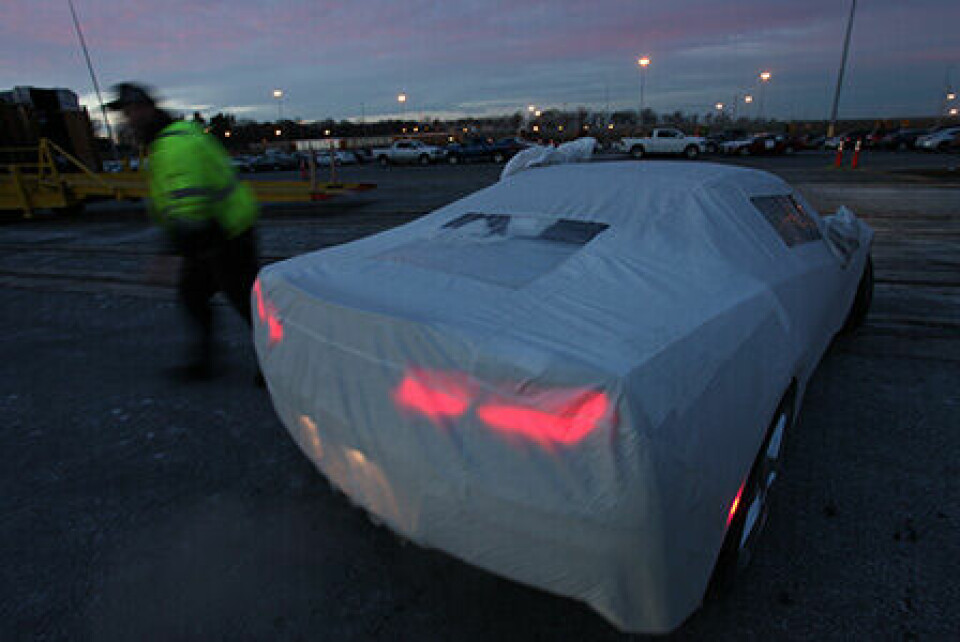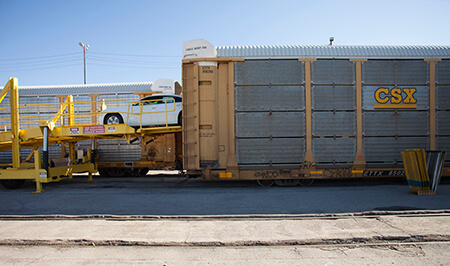When will services be back on track?
 The state of the rail freight service in the US has been a leading topic of conversation for several months within vehicle supply chains, with discussions still ongoing between OEMs and rail providers. Questions around the availability of capacity and transit delays that have disrupted the timing of finished vehicle deliveries became so acute last year that the Surface Transportation Board (STB) within the US House of Representatives asked key stakeholders to come together in Washington for a listening session in October.
The state of the rail freight service in the US has been a leading topic of conversation for several months within vehicle supply chains, with discussions still ongoing between OEMs and rail providers. Questions around the availability of capacity and transit delays that have disrupted the timing of finished vehicle deliveries became so acute last year that the Surface Transportation Board (STB) within the US House of Representatives asked key stakeholders to come together in Washington for a listening session in October.
Hunter Harrison, appointed as CEO and president of CSX in March 2017 (but then replaced by James Foote after his sudden passing-away in December the same year), was called upon to answer questions related to CSX’s service performance, following implementation of his latest version of the ‘precision railroading’ strategy he previously employed in turnarounds at Canadian Pacific (CP) and Canadian National (CN). One of the first upshots of ‘precision railroading’ at CSX, according to media reports, was the laying-off of 2,300 people in 2017, plus the removal of nearly 900 locomotives and 60,000 freight cars from its overall capacity while closing two rail yards.
“The railroads have been chasing operating ratio and, in the drive to cut costs, Hunter Harrison did things much faster than he did them at CP or before that at CN,” observes Jason Kuehn, a vice-president in the rail practice at New York-based consultancy Oliver Wyman. “At CN, he took six to eight years to do this work. He did it in half that time at CP, with the turnaround happening in about four years. At CSX, he was trying to do everything at once, over one summer. That created a lot of change and a lot of disruption. It took a while to get everything sorted out, but the numbers are now better than when he took the reins at CSX.”
According to media coverage of the STB listening session in October, Harrison took the opportunity to apologise to customers impacted by the changes. While he admitted that mistakes had been made in the initial implementation of the strategy, Harrison reaffirmed CSX’s commitment to precision railroading and promised improvements in service.
Another factor related to the current service crisis, in Kuehn’s view, is a general shortage of bi-level rail cars. Since the decline in petrol prices in 2014, demand has been growing for pick-up trucks and SUVs, which require bi-level cars rather than the tri-levels used to move smaller vehicles.
 “Rail cars are a 40-year asset. So adapting to short-term change in the market is something that takes a long time,” observes Kuehn. “A recent innovation, which may help, is a convertible rail car, which can be changed from tri-level to bi-level and back again to better accommodate changes in the marketplace. These new cars are more expensive and, with long-lived assets, it may take a number of years to replace older, fixed-rack cars with enough adjustable rack cars to accommodate such swings in demand.”
“Rail cars are a 40-year asset. So adapting to short-term change in the market is something that takes a long time,” observes Kuehn. “A recent innovation, which may help, is a convertible rail car, which can be changed from tri-level to bi-level and back again to better accommodate changes in the marketplace. These new cars are more expensive and, with long-lived assets, it may take a number of years to replace older, fixed-rack cars with enough adjustable rack cars to accommodate such swings in demand.”
Strategic pressuresLike any business vertical with publicly-traded companies, rail is highly competitive and continually under pressure from investors to deliver performance and profitability. The challenge for the railways is to find an optimal balance that can deliver acceptable levels of investment return for shareholders without sacrificing the service needs of customers. Rail in the US is also unique because of its interconnectivity and the equity rules for equipment that have been established among the railroads, facilitated by rail car pooling company TTX.
Some of the service issues over the past year could conceivably be attributed to the strategies behind such efforts to compete. Kuehn notes that one of the ripples in the rail pool created by the changes CSX implemented to promote efficiencies and bolster the company’s operating ratio also had an impact on Norfolk Southern (NS), the eastern competitor to CSX. Kuehn says the yard closure by NS of the hub in Chattanooga, Tennessee, was one of the cutbacks made in an effort to drive down costs and enhance the operating ratio. In Kuehn’s estimation, it was one of the ways NS responded to moves by CSX.

CSX’s pursuit of ‘precision railroading’ was reported to
have resulted in lay-offs in 2017
The closure of the Chattanooga facility, which has since been reopened, illustrates the domino effect which macro business decisions have had across the automotive supply chain. The rail hub in Chattanooga, located within 25 miles of Volkswagen’s North American production plant, is a critical logistics platform for the carmaker. Ready access to rail was a significant selling point for Chattanooga in seeking to secure VW’s original commitment to the site. The Chattanooga closure, in Kuehn’s view, caused congestion and delays with impacts felt in Atlanta and Birmingham as well as those experienced by VW.
“I honestly don’t think, when the two railroads [CSX and NS] sat down to figure out how to drive efficiencies through their organisations, that they said ‘well, we’re going to do that at the expense of customer service’,” states Mark Boucher, director, vehicle logistics at Volkswagen Group of America. “When they [NS] closed the Chattanooga yard, they called me and said we would not see any change in performance. Well, our performance was immediately and adversely impacted. Now they’re going to reopen it to some degree and that should give some relief to us. We’re a big shipper in that area, but there’s also other significant industry operating in Chattanooga. We’re all having our issues. It’s not just limited to the automotive group.”
For Boucher and VW, the loss of service levels has resulted in increased transit times and often expense. One of the strategies VW has employed to address this has been to expand the area in which it carries out direct truck shipment of finished vehicles. But VW has been unable to match the capacity that rail traditionally provided – particularly given growing demand for larger vehicles such as its new Atlas SUV.
[mpu_ad]“The Atlas is the biggest car we’ve had here, basically, since the Eurovan back in the '90s and, with three rows of seats, it’s in the wheelhouse of the market right now. When I can’t get them shipped on rail, I have to tell my dealer that they have to tell their consumers the vehicle is delayed. I may not even be able to provide an ETA with any consistency,” says Boucher.
“I have to tell my consumer or my dealer, who is my customer, that they have to tell their consumer it’s going to be an extra couple of weeks or that they don’t know when it’s coming. My other alternative is to put it on a truck at great expense. I’ve been doing this almost two decades and I was on the other side of the table [in the rail sector] for the first part of my career. I can remember when automotive networks were fully scheduled and the railroads did what they said they would do with much greater accuracy.”
Signs of improvementWhile the issue of rail service levels continues to be a subject of considerable debate in the automotive sector, there is a hesitancy by many of those involved to go public about what they are experiencing – certainly, not all of the OEMs with North American plants or the major railroads that Automotive Logistics approached for this article were willing to go on the record.
For the US Surface Transportation Board (STB), keeping an eye on rail service metrics is no mere passing interest. US-based rail operations have been providing weekly reports to the STB for years and the board has made those results available through its website, dating back to 2014.
As a follow-up to the listening session in October and the comments received from trade associations, including the Alliance of Automobile Manufacturers, the STB sent letters in March to all the major rail providers, requesting written responses about the service outlook across their respective networks. This request for information covered such areas as locomotive availability, employee resources, local service performance, demand, communication and capacity constraints.
In a letter to the STB dated March 12, the Auto Alliance – comprising BMW Group, FCA US, Ford, General Motors, Jaguar Land Rover, Mazda, Mercedes-Benz USA, Mitsubishi Motors, Porsche Cars, Toyota, Volkswagen Group and Volvo Cars – presented a range of issues experienced by its members. In particular, the letter noted a serious shortage of bi-level and tri-level rail cars for transporting finished vehicles during February and March. It also suggested that “the rail industry has significantly missed its targets for fulfilling rail car orders, the loaded versus empty rail car ratio, and shippable vehicle ground counts.”
The Auto Alliance letter to the STB also said that meetings by that point in the year between rail providers and their OEM customers to address the issues and related costs had been “unsatisfactory”.
Among those responding to the STB’s request for information was new CSX president and CEO James Foote, who was appointed to the position after Harrison’s death in December. In his response, he said: “CSX is actively working with customers and our interline partners to increase utilisation and reduce turn times of the bi-level car fleet. While bi-level cars are presently constrained across the rail industry, CSX’s network is ready to handle additional auto volumes when the bi-level fleet is restored to more normal levels.”
Foote concluded his comments to the STB by saying: “We firmly believe that a high-performing CSX is one where customers, shareholders and the communities we serve all benefit. We are all driven by our commitment to excellence in safety and customer service.”
In the months since the STB’s approach in March, OEMs, rail providers and industry observers have noted some improvements – though clearly, perceptions about the overall state of the rail industry in the US inevitably hinge on perspective.
The experiences of Ford, GM and FCA are, perhaps, particularly important in this respect. As Boucher admits, VW’s market share in the US is only around 3% – but the experiences of the ‘big three’ could be taken as a leading barometer on the state of current rail services, he says, while the service response of the railroads to their volumes could potentially “move the needle” for the rest of the supply chain.
While declining to be interviewed by Automotive Logistics, two of the ‘big three’ did tell us they had seen improvements in rail performance in recent months, with both suggesting that their North American rail networks were nearly back to normal levels by late May.
In terms of VW’s experience, most of the performance issue is based in the eastern half of the US, says Boucher. “Our two rail partners in the western US, Kansas City Southern [KCS] and the BNSF, have been quite good partners for us. We are pleased with them and they’ve worked very hard to serve our account well,” he comments. “But we all work in a network together. So, when the eastern railroads struggle, we all struggle. I do have to admit that KCS and BNSF have been very good in helping us to develop effective solutions and helping us to be better.”
Doniele Carlson, assistant vice-president of corporate communications and community affairs at KCS, says rail networks are becoming more fluid and showing signs of improvement. She echoes Boucher’s observation that KCS has been successful in collaborating with customers to make network changes to help mitigate some of the congestion.
Meanwhile, Dave Fleenor, assistant vice-president for automotive at BNSF, cites investment over the past few years by his rail line in thousands of new multi-level auto racks, and the addition of capacity at 15 of BNSF’s vehicle facilities, as being among the solutions that have helped to address the needs of the automotive supply chain. Fleenor concedes, however, that the interconnected nature of rail as a transport mode can create the domino effect that automotive and other supply chains have experienced during the past year.
“We’ve seen steady growth in the automotive sector of the rail industry, which can have some impacts to fluidity along rail networks. The 65,000 auto-racks that the industry utilises to move our customers’ vehicles to market are a shared pool,” explains Fleenor. “As a result, disruptions on one railroad can affect others that participate in the pool. The slower velocity of the pool did result in an increase in ground count at various origin facilities, but the network has been more fluid in the second quarter and we have seen a return to more normal levels of inventory.”
Looking down the tracksIn truth, however, it is hard to tell whether things are improving. A spokesperson for the Auto Alliance admits that he could not find “consensus one way or the other as to whether service has improved across the board”, adding: “This is clearly an issue we’ll have to keep monitoring”.
 OEMs, rail providers and industry observers have noted improvements in rail service since the STB’s intervention in March this year, but problems remain
OEMs, rail providers and industry observers have noted improvements in rail service since the STB’s intervention in March this year, but problems remainIn a recent meeting, VW’s Boucher seemed to empathise with his eastern rail provider, saying: “I don’t envy their roles, because I know the commercial people want to provide a product to the OEMs that’s good, or what we’ve historically seen over the years, and they’re not able to because their companies have closed yards, parked locomotives and laid off crews, etc.”
Jordan Kajfasz, managing director of marketing and sales for international intermodal and automotive at Canadian Pacific, says that while automotive offers a mix of challenges and upsides and one doesn’t cancel out the other, it is important to identify the right partners and solutions.
“I think it’s really about delivering what you say you’re going to do. When, in actuality, that doesn’t happen and the customer gets frustrated, I think the key is ensuring that it’s corrected,” says Kajfasz.
[related_topics align="left" border="yes"]“At CP, we measure and monitor. We communicate with our customers regularly. In fact, we measure and monitor down to the rail car with our trip plans. It’s all eyes on performance. For us, that’s the foundation of ensuring that our customers get what they’ve been promised. It’s the foundation of CP. It’s going back to precision-scheduled railroading and it’s what we’ve done here over the past few years.”
Whether the wider US rail industry can follow suit and ensure its customers get what they’ve been promised over coming months is, perhaps, not quite so clear.
 "I’ve been doing this almost two decades and I was on the other side of the table [in the rail sector] for the first part of my career. I can remember when automotive networks were fully scheduled and the railroads did what they said they would do with much greater accuracy." - Mark Boucher, Volkswagen Group of America
"I’ve been doing this almost two decades and I was on the other side of the table [in the rail sector] for the first part of my career. I can remember when automotive networks were fully scheduled and the railroads did what they said they would do with much greater accuracy." - Mark Boucher, Volkswagen Group of America
 Automotive Logistics asked Jason Kuehn (pictured), vice-president of the rail practice at New York-based consultancy Oliver Wyman, about rail providers' responsibility to be responsive; the challenges for both sides; and how OEMs and rail companies could help each other out...
Automotive Logistics asked Jason Kuehn (pictured), vice-president of the rail practice at New York-based consultancy Oliver Wyman, about rail providers' responsibility to be responsive; the challenges for both sides; and how OEMs and rail companies could help each other out...
Most people who follow business understand the desire to increase profitability and provide value to shareholders. With that in mind, how responsive should rail providers be to their automotive customers who are experiencing service issues?Well, I think unreliability of service is one of the biggest criticisms that all shippers have of the rail industry. I don’t think the automotive customers are unique in that area. It’s sort of endemic in the industry.
As an outside party, I would love to see the rail industry focus an awful lot harder on getting consistent in their service product. From my experience of working for railroads, as well as consulting to them for many years, I think most shippers will pay more for consistency of service and reliability than they will for speed because the most disruptive thing to a supply chain is variability.
If you look at the customer-transportation provider equation from the opposite side, what types of challenges does the automotive industry pose for rail?The automotive OEMs are some of the most inconsistent shippers in the rail industry. Their shipping patterns vary. They don’t ship the same volumes to the same places day after day after day. They vary from day to day, week to week.
[Carmakers] have quality holds where they won’t ship anything for a week or two. They have their plant model changeovers in the summertime, which produces a time when most rail assets are sitting idle for two to four weeks a year. The OEMs are no angels either, and in my experience, they’re among the worst in terms of reliability of destination and shipment volumes by destination.”
How important is planning for a railroad, especially when it comes to moving finished vehicles?Ideally, I’d like the same volume shipped every day to the same set of destinations. Then, I can plan my train schedules, how I’m going to move the cars. But if I only have two cars today going to this destination, and the next day I’m going to have 15, do I hold the two to keep up with the 15? Or, do I somehow move the two independently? How I move two cars may be very different than if I had a block of 15 to move through the network.
With automotive, you end up with a lot of variability based on the quarterly numbers because the OEMs try to load as much as they can on a rail car. Keep in mind, as soon as they get it out of their plant, they count it as sold. So, at the end of every quarter, you see this huge volume increase to the extent that every available asset is loaded. Then, at the beginning of the quarter, it drops off again because now they have so much inventory in the pipeline, they don’t know what to do with it all downstream.
The OEMs are as much to blame as the rail in my opinion for very ragged supply chain availability in the automotive industry. It’s a really poorly managed and poorly orchestrated supply chain, and it’s really the fault of all the parties.
If we were to put you in a room with rail providers and OEMs, how would you work with both sides? What recommendations would you make to help create an optimal supply chain?On the railroad side, the rail carriers need to get a lot more interested in providing door-to-door transportation. If you look at CSX up in the Michigan area, they have one big ramp location, and all the OEMs truck to that ramp location to load onto rail. They load the rail cars out and go to another ramp to get unloaded and back on a truck for delivering to the dealers.
 A shortage of bi-level railcars required for bigger and more popular SUVs and pick-ups will take time and investment to resolve
A shortage of bi-level railcars required for bigger and more popular SUVs and pick-ups will take time and investment to resolveThe rail only worries about the rail piece. When you give it (the shipment to a truck), they go direct from the plant to the dealer. If I’m an OEM, that’s a lot easier supply chain for me to manage. I don’t have a bunch of different pieces.
If the rail industry really want to be more competitive, they need to improve their service. They should really look to take responsibility of the entire move from plant to dealer.
On the shipper side, I think the biggest thing that would help the rail would be to do my absolute best to put out the same volume from the plant every day – making sure the quality is there to begin with. You would work to eliminate quality holds, where I’m missing some parts or something happened at the plant that stop shipments for a week or more. Also, I would look at those quarterly ramp-ups that you have for earnings season. Those play havoc with your supply chain providers.
I believe rail has an advantage in the supply chain that it is not exploiting and that’s the ability to forward place inventory into a market. You have the destination rail terminal and that can be a holding place where the OEMs could actually hold inventory before it goes to the dealerships. Trucks can’t do that. Rail can hold the inventory at the plant and then it goes directly to a dealership.
Now obviously, if the demand is really high for a vehicle, you’re not going to be letting it sit anywhere, but new vehicle sales have dropped off in general this year, so I think there’s a lot more slack in the supply chain than there was two years ago. I think the railroads could offer to manage some of your forward inventory for you at our ramp locations closer to the customer.
The other thing the railroads should do is engage the OEMs now about autonomous vehicles, because it’s relatively simple to load vehicles onto a rail car, unlike a truck. You don’t have a bunch of moving hydraulic platforms that you have to adjust to match. It’s basically just a straight deck that you load the vehicle onto. That’s where a lot of damage occurs in the loading and unloading process to get door dings, because there’s not a lot of clearance inside the railcar.





